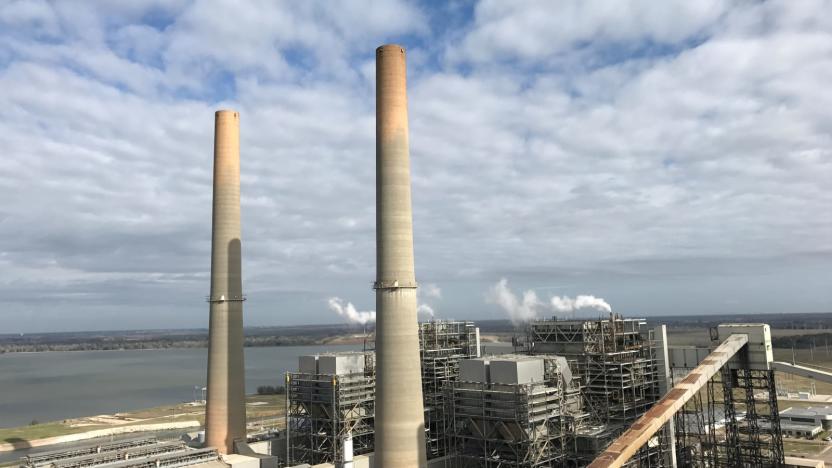co2emissions
Latest

Xprize finalists to test CO2 recycling ideas in power plants
In September 2015, the NRG COSIA Carbon Xprize was born. Through a total of $20 million in reward money, the aim of this particular Xprize is to challenge participants to come up with a way to convert CO2 emissions into something actually useful. Almost two and half years later, and the Xprize crew have now whittled down the contestants from 27 semi-finalists to ten finalists.

Earth's CO2 levels have permanently crossed the 400ppm threshold
Despite the fact that September is typically the lowest month for atmospheric carbon dioxide, the CO2 levels in Earth's atmosphere crossed the symbolic 400 parts per million threshold this month. According to climate scientists, it is extremely unlikely that the planet will ever drop below those levels again in our lifetimes.

Volkswagen 'concludes' CO2 emissions are not a problem
Volkswagen has "largely concluded" that its CO2 emissions problem is smaller than suspected. Based on an internal investigation, the automaker claims that there's no evidence that the fuel consumption numbers had been illegally changed. Their measurement checks reveal that there were only minor discrepancies in a few models that add up to 36,000 vehicles, as opposed to the 800,000 cars that were under initial suspicion. According to a statement "almost all of these model variants do correspond to the CO2 figures originally determined." The models that did reveal false CO2 figures were only off by a few grams and can be readjusted without a recall.

Europe's first solar powered train tunnel goes live on Belgian high-speed line (video)
The train ride from Paris to Amsterdam may not be the most scenic of European railway routes, but it's the only one capable of harnessing the awesome power of the Sun -- for two miles, at least. Yesterday, engineers in Belgium officially switched on Europe's first solar-powered train tunnel, spanning a 2.1-mile stretch of the rail line connecting the City of Lights to Mokum. The installation's 16,000 solar panels will be used to provide 50 percent of the energy needed to power nearby Antwerp Central Station and to provide extra juice for both high-speed and traditional trains. Originally developed to help protect travelers from falling trees in an ancient forest, the project is expected to produce up to 3.3MWh 3,300 megawatts hours per year, while decreasing annual CO2 emissions by about 2,400 tons. Speed past the break for some aerial footage of the artery, along with a brief PR from Enfinity -- the Belgian renewable energy company that helped bring it to life. Update: According to the AFP, the tunnel will produce 3,300 megawatts hours per year.

Oculus3D vies to be the greener solution in disposable 3D shades
As of December, RealD cinemas alone served 100 million moviegoers, and even if the vast majority recycle, that's still a ton (probably several thousand tons, in fact) of plastic 3D glasses. According to a company called Ceroplast, those glasses aren't biodegradable; if so many as 10 million pairs end up in a landfill, it would result in C02 emissions equivalent to burning 50,000 gallons of gasoline. Of course, Ceroplast wouldn't be quoting statistics if it didn't have a greener solution. Under the brand of partner Oculus3D (whose co-founder Lenny Lipton is RealD's former CTO), it's presently making biodegradable polarized shades out of polylactic acid that it intends to deploy -- along with the company's proprietary OculR projectors -- as early as summer of this year. As for which theatres you should expect to see them in, well, we're still in the dark on that one.

Apple's Mac mini tops chart of 'green' computers
The sust-it website, which provides rankings of energy usage and annual energy cost for thousands of appliances, home entertainment devices, and computers, has announced that Apple's Mac mini fills the top four spots for the most efficient desktop computer in their latest listing. The 2.0 GHz Intel Core 2 Duo Mac mini is at the top of the chart, sipping just .94W when turned off (power still goes to circuits monitoring the power status of the computer), 1.71W when in sleep mode, and just 12.6W when turned on but in an idle mode. sust-it calculated the energy cost per year for the mini (without a monitor, of course) as US$5.51 when calculated with the average US electrical rate. It's interesting to note that this model is no longer produced by Apple, and that the new 2.26 GHz mini is even more energy efficient. Apple's own environmental report for the mini shows that the revised model uses only .80W when turned off, 1.39W in sleep mode, but 13.4W while in idle mode. Not surprisingly, other Apple models were near the top of the charts in both the laptop and all-in-one computer categories. The 1.86 GHz MacBook Air was barely edged out of first place in the laptop category by the HP Pavilion DM3. Although the two laptops had identical annual energy costs (US$2.39), the HP model had lower sleep and off power consumption than the MBA. In the all-in-one category, the top iMac came in 6th behind eMachines, Acer, Asus, and MSI all-in-ones. Although the sust-it site is citing an iMac model that is no longer produced, even the new iMacs would be a bit behind the list-leading eMachines EZ1601. If the power consumption and CO2 footprint of your computer is of concern to you, the sust-it site is a good place to make comparisons. Be aware, however, that due to the fast-paced changes in the computing world, the lists may be inaccurate at any particular point in time. In addition, it doesn't appear that sust-it looks at the total lifecycle energy consumption of the computers, something that Apple provides in their environmental reports for each model. When energy consumption and CO2 production are factored from raw materials at the beginning of production to recycling of an obsolete machine, Macs may very well lead the pack in all categories.



